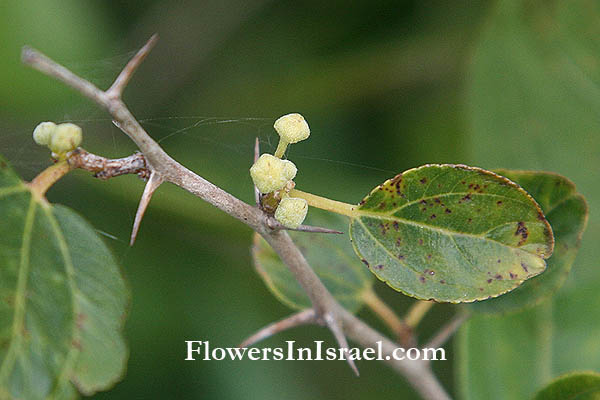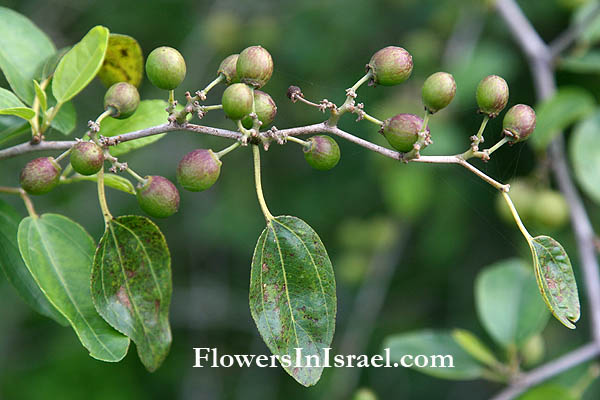|
|
| Life form: |
| Phanerophyte, shrub |
| Spinescence: |
| Stipules |
| Life form: |
| Up to 200 cm high, branches verticillate, with two thorns one straight and the other curved |
| Leaves: |
| Alternate, oblong-ovate; entire, smooth, glabrous |
| Flowers: |
| Inflorescence glabrous racyme; Corolla green or yellow, 2 mm long,
spathulate |
| Fruits / drops: |
| Drupe elliptic, red or dark brown; encloses a hard stone in the centre |
| Flowering Period: |
| March, April |
| Habitat: |
| Batha, Phrygana |
| Distribution: |
| Mediterranean Woodlands and Shrublands, Semi-steppe shrublands |
| Chorotype, טיפוס התפוצה: |
| Med - Saharo-Arabian |
| Summer shedding: |
| Perennating |

Derivation of the botanical name:
Ziziphus, the ancient Greeks called the tree zizyphon, from the Arabic zizouf, a name for the mythical lotus. This was taken into Latin as zizyphum, or zizypha for the fruits.
lotus, lotos, λωτός; a small Mediterranean tree or shrub whose fruit was eaten by the lotus-eaters.
The Hebrew name:שיזף, sheizaf, from Arabic zizouf.
- The standard author abbreviation L. is used to indicate Carl Linnaeus (1707 – 1778), a Swedish botanist, physician, and zoologist, the father of modern taxonomy.
- The standard author abbreviation Lam. is used to indicate Jean-Baptiste Lamarck (1744 – 1829), a French botanist.
It is closely related to Ziziphus zizyphus (Jujube), and is often regarded as the Lotus tree of Greek mythology.
Homer (ca. 8th century BCE), The Odyssey (Ὀδύσσεια) 9:82: “Thence for nine days' space I was borne by direful winds over the teeming deep; but on the tenth we set foot on the land of the Lotus-eaters, who eat a flowery food. There we went on shore and drew water, and straightway my comrades took their meal by the swift ships. But when we had tasted food and drink, I sent forth some of my comrades to go and learn who the men were, who here ate bread upon the earth; two men I chose, sending with them a third as a herald. So they went straightway and mingled with the Lotus-eaters, and the Lotus-eaters did not plan death for my comrades, but gave them of the lotus to taste. And whosoever of them ate of the honey-sweet fruit of the lotus, had no longer any wish to bring back word or to return, but there they were fain to abide among the Lotus-eaters, feeding on the lotus, and forgetful of their homeward way. These men, therefore, I brought back perforce to the ships, weeping, and dragged them beneath the benches and bound them fast in the hollow ships; and I bade the rest of my trusty comrades to embark with speed on the swift ships, lest perchance anyone should eat of the lotus and forget his homeward way. So they went on board straightway and sat down upon the benches, and sitting well in order smote the grey sea with their oars".
Herodotus (ca.484 BCE–ca.425 BCE) ,Histories, Book IV, 177: "In a peninsula which stands out into the sea from the land of these Gindanes dwell the Lotophagoi, who live by eating the fruit of the /lotos/ only. Now the fruit of the lotos is in size like that of the mastich-tree, and in flavour it resembles that of the date-palm. Of this fruit the Lotophagoi even make for themselves wine. Next after the Lotophagoi along the sea-coast are the Machlyans, who also make use of the lotos, but less than those above mentioned".
Lotus-eaters (Lōtophagoi), in Homer's Odyssey 9, a fabulous people whose land Odysseus visits. They live on the lotusfruit, whose property is to make those who eat it forget their home and desire to remain for ever in Lotus-land.
Sidrat al-Muntahā (Arabic: سدرة المنتهى) is a lotus tree that marks the end of the seventh heaven, the boundary where no creation can pass, according to Islamic beliefs (Qur'an 53:14).
Bible resources:
- Job 40:21-22
Under the lotus plants it lies, hidden among the reeds in the marsh.
The lotuses conceal it in their shadow; the poplars by the stream surround it.
|

